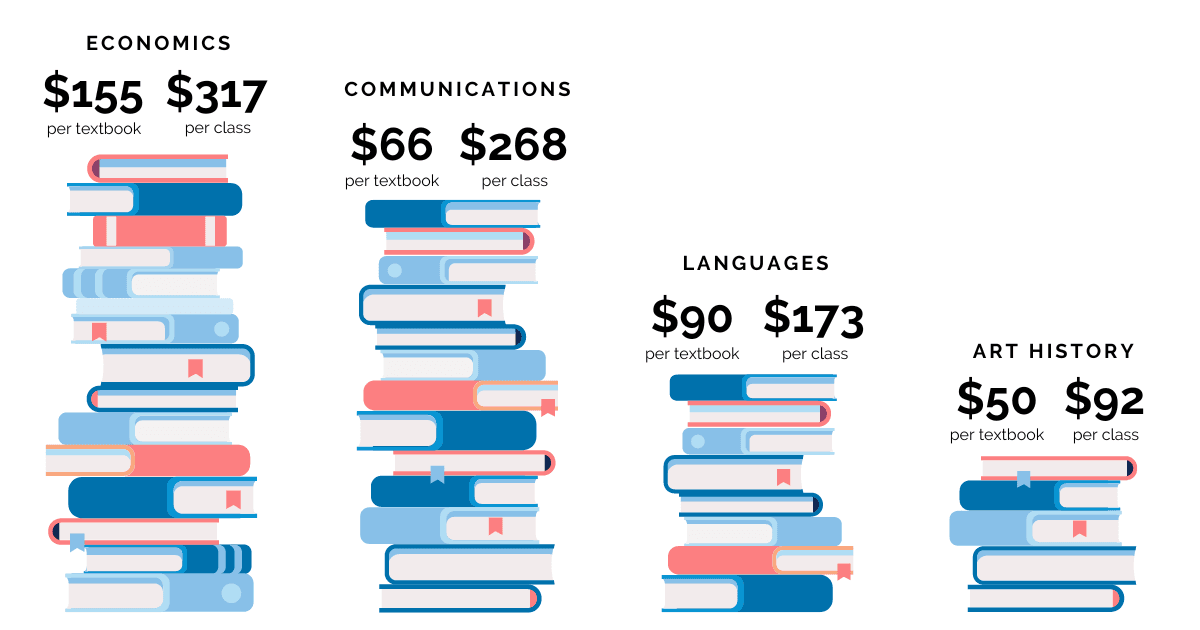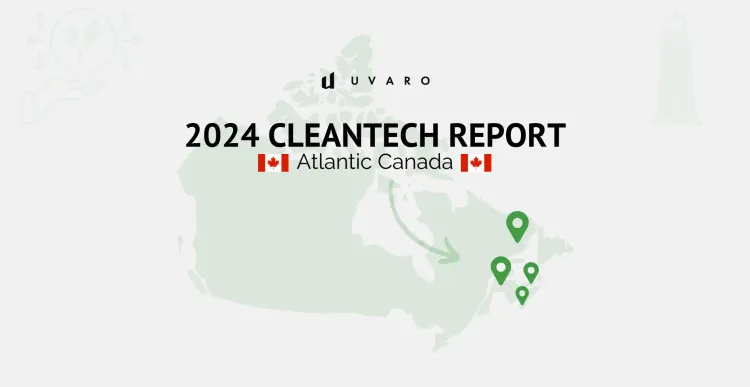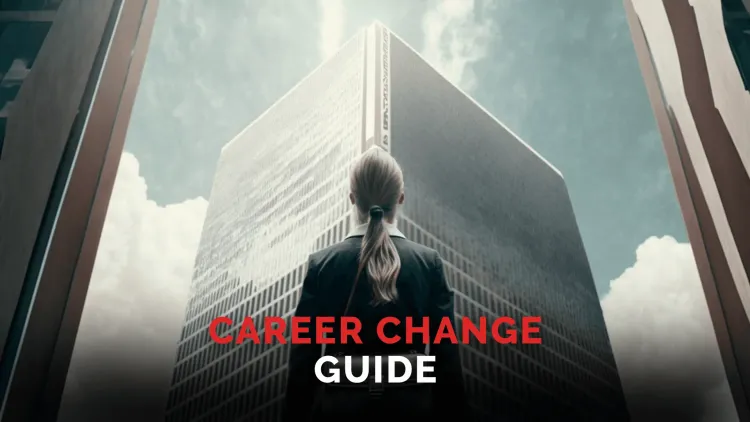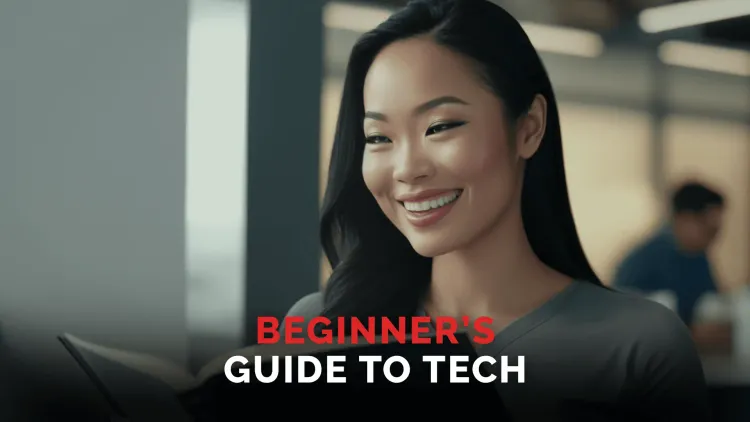The Average Cost of College Textbooks Over a 4-Year Degree
If you're a student, or the parent of one, take a closer look at the price of a college textbook with this breakdown of how much they cost. Spoiler: It's not pretty.

Sep 14, 2022
College textbooks. Yeah, those things that end up being one-time reads and wind up collecting dust in a drawer or lining your bookshelf after a semester. Sure, they’re heavy and often complicated, but they also form the — literal — bulk of your education.
While they may be essential to your learning, they’re also a major financial investment.
Did you know that college/university textbooks can cost over $1,200 a year? Or that the cost of textbooks has increased by 82% in the past decade? It’s important to make sure that you know exactly what you’re in for as you get ready for University or College, as many fail to count for textbook costs ON TOP of their tuition costs when planning their budgets.
To say that textbook costs have spiraled out of control is an understatement, but you certainly can’t go without them, either. So what’s a student to do?
In this guide, we’ll go over the cost of textbooks for a 4-year degree. We’ll also touch on the history of the price of textbooks and what future students can do to save on costs.
The Reality of the Current Situation
The Fun” Facts
- Americans spend roughly $700 to $1,000 per year on textbooks
- The US textbooks industry is valued at $33.3 billion
- Since 2006, the price of textbooks has increased 4x faster than inflation
- The average cost of public school district textbooks per student per year is $250
- Community college students are 2x more likely to buy textbooks with financial aid than 4-year college students
- 30% of post-secondary school students use financial aid money to buy textbooks
- 5 textbook publishers (Pearson, McGraw, Scholastic, Cengage Learning, and Houghton Mifflin Harcourt) control 80% of the market
- 67% of students buy old textbooks to save on costs
In the last 3 decades, the cost of textbooks has gotten so extreme that 30% of students say they use financial aid money to buy textbooks. And to think your parents put themselves through college with a summer job. But why does the price of textbooks keep rising year after year? And how do textbook prices compare with inflation?
How Textbook Prices Have Changed
From 1977 to 2015, textbooks increased in price by 1,041%. Yes, that’s right. Over 1,000% in 30 years. The data comes from NBC’s review of data from the Bureau of Labor Statistics.
Nicole Allen, the Director of Open Education for SPARK, argues that publishers have managed to increase the prices yearly because students are captive consumers.” Lucky them, right?
As if waking up for morning lectures wasn’t enough of a hassle, now you’ve got to worry about lugging over $1,000 of books to and from class. It’s mind-boggling how much we get used to the fact our books now cost what some people get paid in a week.
Naturally, students are drawn to ask, Was it always this way?”
According to Priceonomics, the major upward shift in prices for college textbooks occurred in the 70s, and it hasn’t stopped. The major cause of price increases is inflation — it’s become something of a buzzword these days, hasn’t it? A textbook that cost $12 in the 1970s would cost $44 today.
Another textbook price review conducted by the Government Accountability Office found that between 2003 and 2013, the price of college textbooks rose 82% — nearly 3x the cost of inflation. On top of your tuition, the barrage of textbooks you need for classes can feel insurmountable. A lot of students even wonder whether college is worth it at this point.
The PIRG report surveyed 2,000 students from over 100 colleges and found that:
- 65% said they had decided not to buy textbooks because they were too expensive
- 48% said the cost of books had an impact on the number of classes they took
- 94% of those who had skipped purchasing a required textbook said they were concerned that doing so would hurt their grades.
Publishers, on their part, have begun to acknowledge that college textbooks have become so expensive that students simply can’t afford them. Textbook publishers claim that technologies like digital textbooks and other book-based subscription services are now an affordable option. But critics argue that publishers are the ones to blame for the price problem in the first place.
Why College Textbooks are So Expensive
College Board found that the average college student spends roughly $1,200 annually on textbooks. That’s about 39% of tuition in a community college or 14% in a public 4-year college. But why’s the cost of textbooks so high in the US?
1. A Flawed Textbook Market
The PIRG says the textbook market is flawed,” and it’s the dysfunctional market that’s led to unmanageable book costs for students.
You might not have taken Economics 101 yet, so let us fill you in. In a typical business market, we have the law of supply and demand. When something is in demand (that is, people want to buy it), prices are lower. Why? Because the consumers choose products with the highest value, businesses compete with each other by lowering their prices to meet the demand.
Still with us?
Now, we all know textbooks are in demand. Maybe not entirely by choice (captive audience, remember?), but nevertheless, students need them. With thousands of college students in America, how has there not been enough demand to stop the horror of inflation?
It’s because of how the market is structured.
You know you need your textbook, and you can’t go without it. So, rather than demand a lower price, consumers are forced to pay whatever a publisher charges. Even if that cost is ridiculous and could be much better spent elsewhere, like much-needed coffees and paying down student debt.
Students don’t get to choose how much they pay, so the market just keeps getting more expensive. But what will happen when no one can afford books anymore? It’s hard to say so far, but we can definitively say the market is reaching its breaking point for most students.
2. Fewer Players
Another reason why textbooks are so expensive is that few publishers control the industry. Almost 80% of the textbooks industry in the US is dominated by 5 publishers.
Like influencers on social media, they dominate the market. Everyone goes to them for the best material, so they ultimately get to do whatever they want. It’s not exactly fair, but that’s the nature of the game.
Now, this isn’t to say that all publishers are big, bad evil corporations that only want to rob students’ of their hard-earned money, savings, and book vouchers. Some of them make efforts to lower costs and keep books affordable.
But these marginal efforts haven’t been enough to budge the impenetrable costs.
Students started buying used textbooks or borrowing from other people, which lowered the cost of demand for new books. There were also students who bought digital copies and spread the love with their friends.
Unfortunately, publishers responded by bundling their new books with special codes that restrict access, forcing students to buy new textbooks. A 2016 survey found that 66.6%% of students didn’t buy a required textbook, and 37.6% got a poor grade because they couldn’t afford a required reading.
3. Publisher Profits
We all want money. Book publishers aren’t any different. The simple truth is that charging more for textbooks means earning more from every sale.
A higher price tag means a better bottom line for these businesses.
With only a few players in the industry, the lack of competition makes for a less competitive market. Publishers are able to get away with steeper prices because there are no smaller, independent companies that can hop in and offer lower prices.
And since students aren’t going to just go without textbooks, they’re forced to accept whatever rates the market throws their way.
The Cost of Textbooks Spread Across Different Degree Types
Not all textbooks hold the same price point. In most cases, the prices of textbooks depend on the course and the complexity of the subject. For example, textbooks for humanities courses, like Art History, cost significantly less than books for Medicine and Engineering.
Some textbooks, particularly those in Biochemistry, can be incredibly expensive. For example, at the UVA Bookstore, a Biochemistry textbook will set you back over $400. Maybe if you fold it a certain way and sleep under it, you won’t need to pay rent to offset the costs.
The top most expensive subjects broken down by cost per textbook is Physics and Engineering, with English Literature the most inexpensive. That being said, one must also consider how many textbooks you might need per course. As shown below, there is the cost per textbook, but if your class requires multiple, well, you see how that plays out.
Alternative Solutions
While the stats are disheartening, it’s not all doom and gloom. By using these tips, you can lower your financial burden and manage to eat more than ramen and vending machine meals during your studies:
- Apply for Scholarships • There are scholarships specifically to cover textbook costs at many educational institutions.
- Check for Open Educational Resources • Commonly known as OERs, these open-source materials are specifically developed for free use and distribution.
- Share • You could share textbooks with classmates or roommates taking the same course as you. Have a group study session and share a book while you take notes.
- Rent • You can easily return the rental at the end of the semester, and it’s up to 50% cheaper than buying your own book.
- Opt for the e-book • It may be more cost-effective to buy a kindle — or even a brand new iPad — and e-copies of your textbook than buy the entire syllabus. Your wallet and backpack will thank you for the lighter load.
- Library • Your professor will normally make a copy or two of the textbook available at the campus library. Use that student card to read your needed material then return it when done.
Take a different approach to your education
College textbooks can cost a significant amount on top of the already skyrocketing tuition costs that students are now paying. This poses a major challenge to students who wind up avoiding certain subjects or not buying books that could truly enhance their education.
In some cases, there are also alternatives to traditional college degrees that can set you up for a bright future. If you’re looking for an affordable way to develop skills and get coaching for your dream job, Uvaro is your best bet.
With career-oriented courses that last between 4-12 weeks, and lifelong support and coaching post-graduation, many are shocked to see the difference that a Career Success company can offer versus a traditional university or college. Download our Career Success Catalog to start learning more, and depending on your goals, Uvaro might just be right for you.





